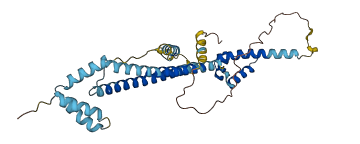Q19503
Gene name |
ceh-40 (F17A2.5) |
Protein name |
Homeobox protein ceh-40 |
Names |
|
Species |
Caenorhabditis elegans |
KEGG Pathway |
cel:CELE_F17A2.5 |
EC number |
|
Protein Class |
|

Descriptions
The autoinhibited protein was predicted that may have potential autoinhibitory elements via cis-regPred.
Autoinhibitory domains (AIDs)
Target domain |
|
Relief mechanism |
|
Assay |
cis-regPred |
Accessory elements
No accessory elements
Autoinhibited structure

Activated structure

1 structures for Q19503
| Entry ID | Method | Resolution | Chain | Position | Source |
|---|---|---|---|---|---|
| AF-Q19503-F1 | Predicted | AlphaFoldDB |
No variants for Q19503
| Variant ID(s) | Position | Change | Description | Diseaes Association | Provenance |
|---|---|---|---|---|---|
| No variants for Q19503 | |||||
No associated diseases with Q19503
1 GO annotations of cellular component
| Name | Definition |
|---|---|
| nucleus | A membrane-bounded organelle of eukaryotic cells in which chromosomes are housed and replicated. In most cells, the nucleus contains all of the cell's chromosomes except the organellar chromosomes, and is the site of RNA synthesis and processing. In some species, or in specialized cell types, RNA metabolism or DNA replication may be absent. |
2 GO annotations of molecular function
| Name | Definition |
|---|---|
| DNA-binding transcription factor activity, RNA polymerase II-specific | A DNA-binding transcription factor activity that modulates the transcription of specific gene sets transcribed by RNA polymerase II. |
| RNA polymerase II cis-regulatory region sequence-specific DNA binding | Binding to a specific upstream regulatory DNA sequence (transcription factor recognition sequence or binding site) located in cis relative to the transcription start site (i.e., on the same strand of DNA) of a gene transcribed by RNA polymerase II. |
4 GO annotations of biological process
| Name | Definition |
|---|---|
| animal organ morphogenesis | Morphogenesis of an animal organ. An organ is defined as a tissue or set of tissues that work together to perform a specific function or functions. Morphogenesis is the process in which anatomical structures are generated and organized. Organs are commonly observed as visibly distinct structures, but may also exist as loosely associated clusters of cells that work together to perform a specific function or functions. |
| embryonic organ development | Development, taking place during the embryonic phase, of a tissue or tissues that work together to perform a specific function or functions. Development pertains to the process whose specific outcome is the progression of a structure over time, from its formation to the mature structure. Organs are commonly observed as visibly distinct structures, but may also exist as loosely associated clusters of cells that work together to perform a specific function or functions. |
| neuron development | The process whose specific outcome is the progression of a neuron over time, from initial commitment of the cell to a specific fate, to the fully functional differentiated cell. |
| regulation of transcription by RNA polymerase II | Any process that modulates the frequency, rate or extent of transcription mediated by RNA polymerase II. |
7 homologous proteins in AiPD
| UniProt AC | Gene Name | Protein Name | Species | Evidence Code |
|---|---|---|---|---|
| P40425 | PBX2 | Pre-B-cell leukemia transcription factor 2 | Homo sapiens (Human) | PR |
| P40424 | PBX1 | Pre-B-cell leukemia transcription factor 1 | Homo sapiens (Human) | PR |
| O35984 | Pbx2 | Pre-B-cell leukemia transcription factor 2 | Mus musculus (Mouse) | PR |
| Q75LX7 | OSH10 | Homeobox protein knotted-1-like 4 | Oryza sativa subsp japonica (Rice) | PR |
| Q75LX9 | Os03g0673500 | Putative homeobox protein knotted-1-like 5 | Oryza sativa subsp japonica (Rice) | PR |
| Q1PFD1 | BLH11 | BEL1-like homeodomain protein 11 | Arabidopsis thaliana (Mouse-ear cress) | PR |
| Q9SIW1 | BLH7 | BEL1-like homeodomain protein 7 | Arabidopsis thaliana (Mouse-ear cress) | PR |
| 10 | 20 | 30 | 40 | 50 | 60 |
| MSEASKSIMD | LLSEVVKITD | MTMDNEAVNK | LKPQIKINPF | YRAVQDVLVE | QKSKIDLSTK |
| 70 | 80 | 90 | 100 | 110 | 120 |
| MMKDLEAQEN | DERLDTMLKA | EGVAGPDDSL | LRIQEAAGTD | QYEYRQQLLK | VRRELENETK |
| 130 | 140 | 150 | 160 | 170 | 180 |
| AFDKHCKKWC | EYVEDVLQQQ | GEFRPITQQS | TEKFMNKMSG | KFNKVCFVLK | QTACEEVIQL |
| 190 | 200 | 210 | 220 | 230 | 240 |
| KKRYLDARRK | RRNFSKTSTE | ILNEYFLANI | NHPYPSEEVK | QALAMQCNIS | VAQVSNWFGN |
| 250 | 260 | 270 | 280 | 290 | 300 |
| KRIRYKKTMA | KNEDERRENR | KPEDRPPPGA | PGAPYSLVPN | AFAGMMNPYQ | MMLPGHQFPI |
| 310 | 320 | ||||
| GVAPFNFSMY | NPEMMAQYQQ | SLQNPNQTR |